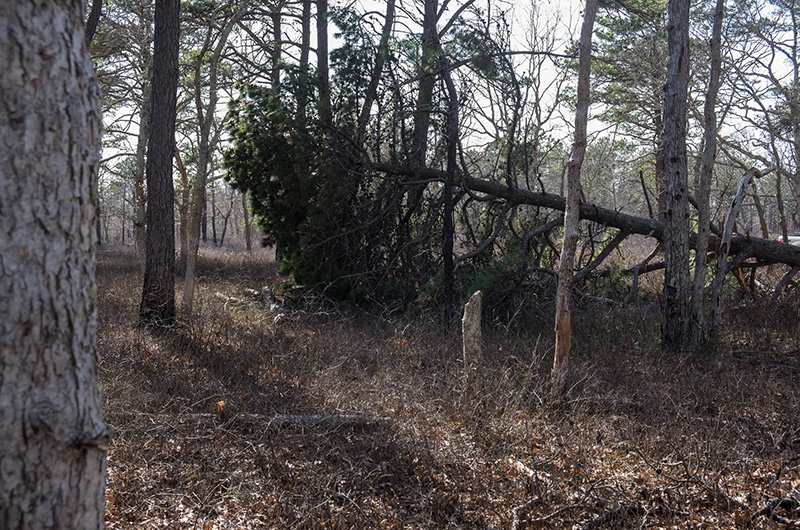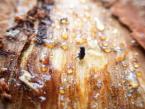Nearly two months after a string of northeasters battered the Island with hurricane-force winds, Island environmental groups are still cleaning up thousands of downed trees. Most trees that were blocking roads to houses have been cleared, but at parks and conservation land around the Island there is much more work to be done.
At Manuel F. Correllus State Forest, about 25 per cent of hiking and biking trails are blocked off due to storm debris as the summer season approaches. The proliferation of wood and brush on the ground also poses a serious fire danger, particularly in populated areas of the state forest, according to state forest superintendent Chris Bruno.
“There’s a lot of fuel on the ground to fuel a fire,” he said. “You want to be cautious and mitigate it.”
On Wednesday afternoon Mr. Bruno drove his truck down a dirt road into the heart of the forest where dozens of trees had collapsed, including one that was split down the middle as if struck by lightning. A native pitch pine that Mr. Bruno said was likely over 40 years old rested horizontally on the forest floor, its roots and trunk exposed in the low afternoon sun.
Mr. Bruno said these were just a few of the thousands of trees in the 5,300-acre forest that didn’t survive the storms.
“There are areas where there is one after another, 40 to 50, every 50 yards,” he said.

A combination of elements led to the high number of trees coming down, according to Adam Moore, executive director of the Sheriff’s Meadow Foundation. For one, the storms hit during a period of blizzard-like conditions. Mr. Moore said the heavy, wet snow clung to trees and weighed them down, causing more damage.
The Island’s large population of coniferous evergreen trees, such as pitch pines, which are thickly coated with pine needles, were especially hard hit. Whereas wind whips right through bare oak trees, Mr. Moore explained, the needles on coniferous trees bear the full impact of wind gusts.
“They catch the wind like a sail would,” he said, citing a large number of pitch pines that fell in the West Chop Woods during the March storms.
Mr. Moore said his staff and a team of volunteers have been hard at work cleaning up Sheriff’s Meadow properties and parts of the state forest that connect the two, though he added there is still much to be done. He said the group can handle the small debris, such as branches and brush, but has had to hire contractors to remove trees that are too big or dangerous to handle on their own.
Martha’s Vineyard Land Bank superintendent Ian Peach said the group has been keeping their chainsaws sharp as they continue to clear debris from the 3,100 acres spanning more than 70 properties that they manage. No properties or trails had to be closed down, Mr. Peach said, but they are still working on making some areas more accessible.
“It was certainly a rough March,” he said. “It was like we got a fresh layer of debris-like mulch on the trails.”
He said the land bank hopes to fashion some of the sturdier trees, such as oaks, into the tops of benches. He said they also plan to chip some of the debris down and use it to help resurface trails and keep them from eroding.
Three old, rare conifers had their roots ripped right out of the ground at the Polly Hill Arboretum, said executive director Tim Boland. He said people shouldn’t be deceived by the large established trees because the roots are typically buried only two feet into the sandy, gravelly soil, and are easily yanked out by the wind.
“We call them the widowmakers,” he said. “They are very vulnerable.”
Mr. Boland said the arboretum has been cleared out with the help of volunteers, but visitors should still be wary and look above their heads for partially snapped branches while they walk around the property.
Some of the valuable wood gleaned from the arboretum’s trees will also have a recycled use, he added. Mr. Boland plans to use eight-foot boards sectioned off from the trees to create wood benches for the arboretum.
Though tree damage is significant, each person emphasized that there are actually several environmental benefits to big, older trees coming down. Mr. Bruno explained that the new openings in the forest canopy allow light to shine through and nourish younger trees and plants.
“It opens up the forest canopy cover just like a shade on a window,” he said. “When you pull shades back, it allows the sunlight to penetrate the forest floor, which stimulates growth.”
Mr. Bruno also outlined several wildlife benefits that arise from more plant growth on the forest floor. He said that the growth might discourage deer ticks by attracting more birds that might eat the ticks. He added that visitors may start seeing more rabbits in some areas and the natural thinning of the forest will make clearer sightlines for birders.
“It allows for more habitat for other species and gives coverage to ground-loving animals,” he said.
Mr. Moore agreed, echoing that the transition from old to new trees enriches the forest floor. He said that the falling trees can cause safety hazards and property damage, but from nature’s point of view, there’s no harm done.
“This is a totally natural occurrence,” he said. “I don’t think this will have a significant ecological impact.”








Comments
Comment policy »